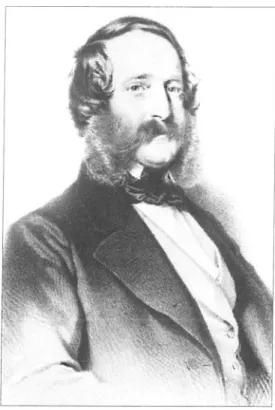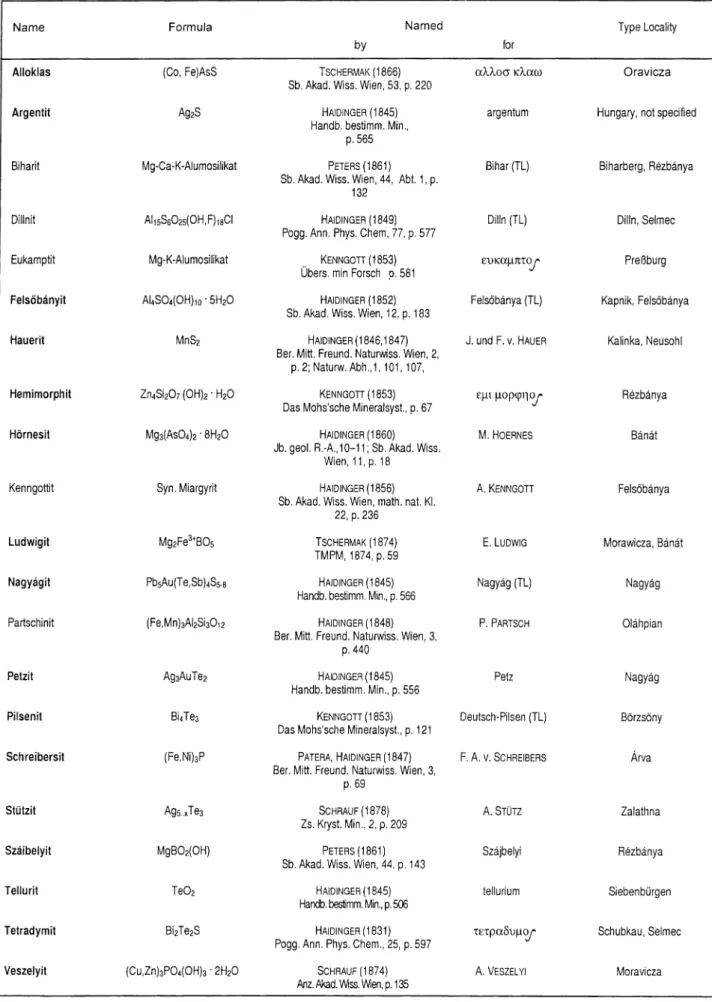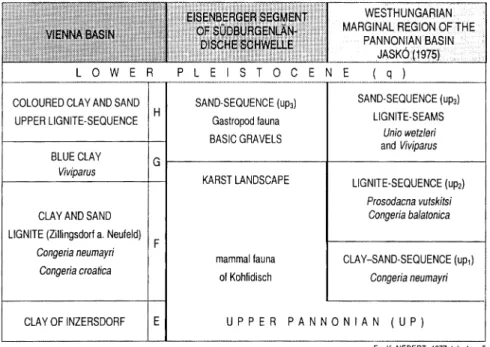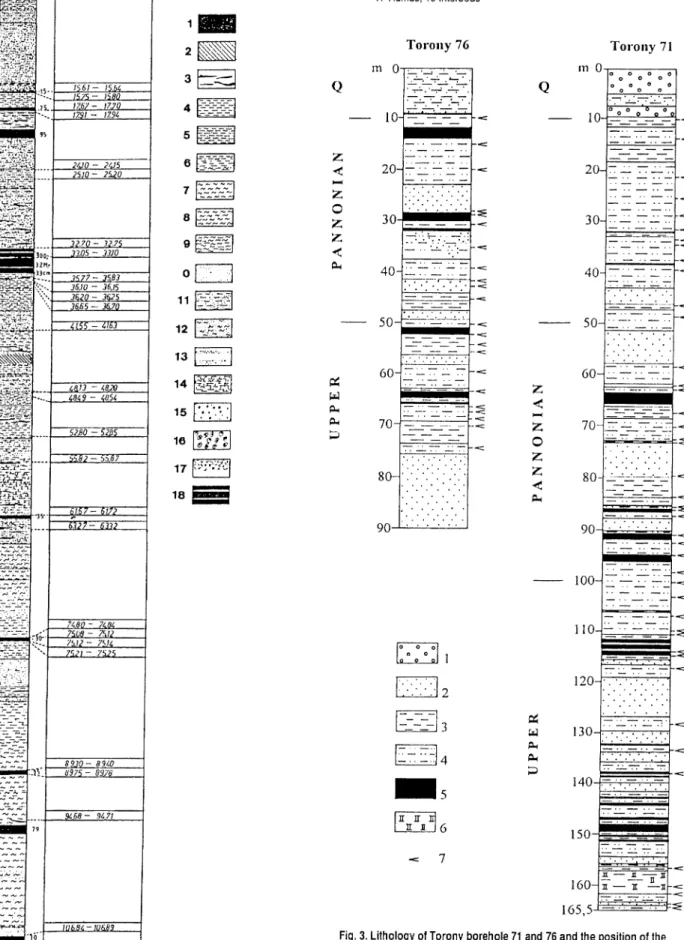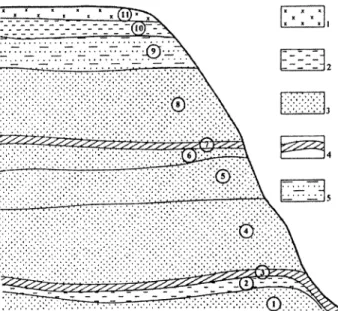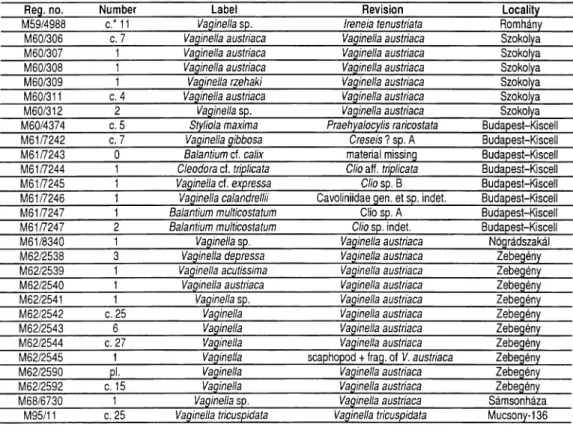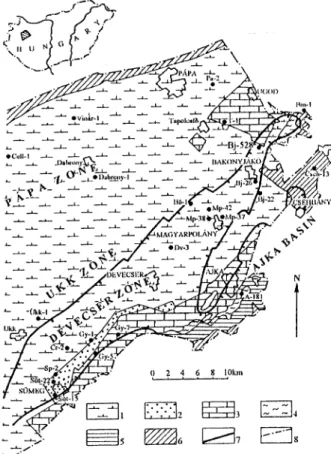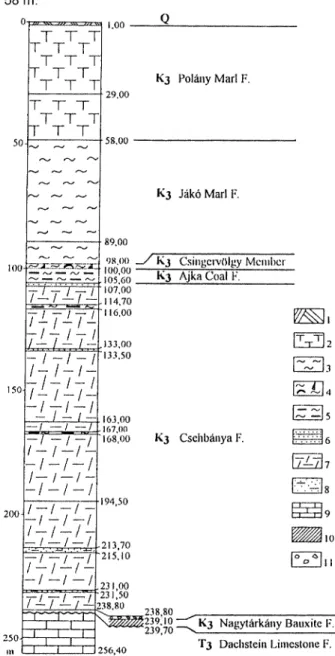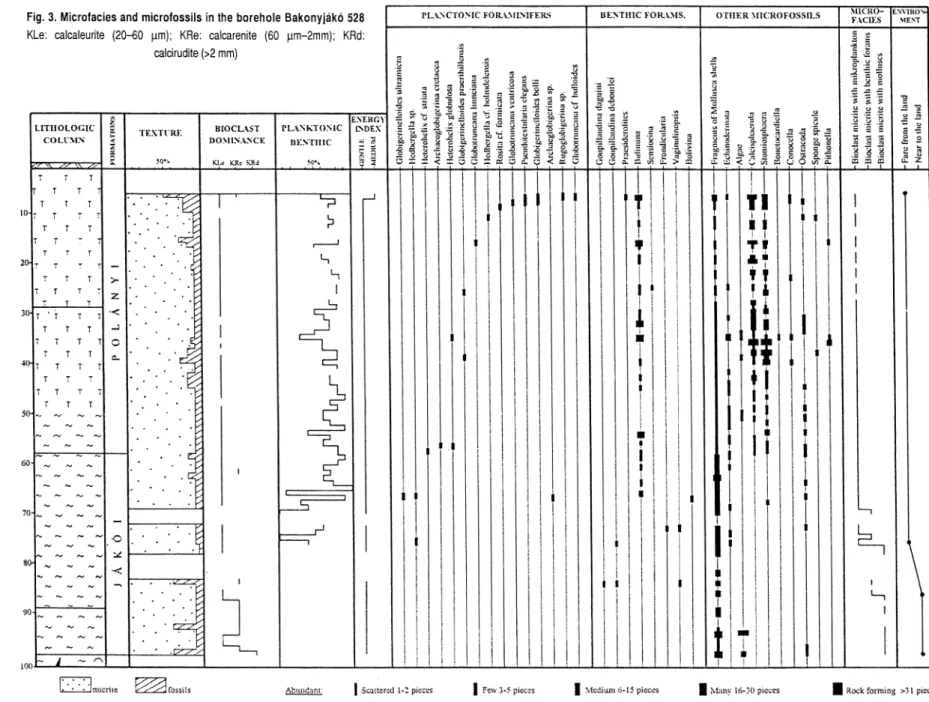GEOLOGISCHE BUNDESANSTALT
ADVANCES
in
Austrian— Hungarian Joint Geological Research
A D V A N C E S
in Austrian— Hungarian ]o in t Geological Research
Detail o f the page "Hungária" o f the Mercator— H ondius'Atlas, published 1607
Marsigli, Luis Ferdinand: Cane Partculiére de La Hongne et de le Danube. La Haye, 1741
Budapest, 1996 ADVANCES
in
Austrian— Hungarian Joint Geological Research
Contents
Directors’ Preface
Hans-Peter Schönlaub Gaál Gábor
Geologische Bundesanstalt Magyar Állami Földtani Intézet 7
Harald Lobitzer
GBA
Editors’ Introduction
Dudich Endre
MÁFI 8
HISTORY OF GEOLOGY
Ups and Downs — the Hungarians in the Austrian Empire from 1740 through 1869
Endre Dudich 11
The first hundred years of teaching geological sciences at the Selmecbánya (Schemnitz) School (later Academy) of Mines
Lá s z l ó Zs á m b o k i 19
Austro-Hungarian geological mapping before 1869
Károly Brezsnyánszky 25
Austria’s contribution to the mineralogical exploration of Hungary until 1869
Albert Schedl & Otto Schermann 33
Austria’s contribution to the palaeontological research in Hungary until the foundation of the Royal Hungarian Geological Survey in 1869
Franz Stojaspal 39
STRATIGRAPHY
&
PALEONTOLOGY
Palynology of the middle Upper Pannonian lignite occurrences in the area of Torony-Höll-Deutsch-Schützen-Bildein (Hungary/Austria)
Ilse Draxler, Eszter Na g y, Günther Pascher & Reinhard Zetter 45 5
A representative leaf assemblage of the Pannonian Lake
from Dozmat near Szombathely (West Hungary), Upper Pannonian, Upper Miocene
Lilla Hablyand Johanna Kovar-Eder 69
Revision of Hungarian Tertiary holoplanktonic gastropods housed in the collections of the Hungarian Museum of Natural History in Budapest
Irene Zorn & Margit Bohn-Havas 83
Integrated stratigraphic correlations of the Upper Cretaceous sequence in the borehole Bakonyjákó 528
Miklós La n to s, Michael Wag r e ic h, Ágnes Siegl-Fa r k a s, Erika Bo dnár, Géza Császár 97 Dasycladaceae from “Zaimkalk” (dagoonal Bachstein Limestone)
of the Mandling Unit (Styria, Austria)
Olga Piros, Gerhard W. Mandl & Harald Lobitzer 119 Correlation of palyno- (spores, pollen, dinoflagellates) and calcareous nannofossil zones
in the Late Cretaceous of the Northern Calcareous Alps (Austria) and the Transdanubian Central Range (Hungary)
Ágnes Siegl-Farkas & Michael Wagreich 127 Bivalve assemblages from the Austrian and Hungarian Hierlatzkalk (Lower Jurassic): a comparison
István Szente 137
GEOCHEMISTRY, PETROLOGY
8C
APPLIED GEOLOGY
Organic geochemistry and facies of the Carnian Göstling Beds and Opponitz Formation (Northern Calcareous Alps, Austria)
Alice Brukner-Wein, Harald Lobitzer & Pavel Müller 149 Young alkali basalt volcanism from the Graz Basin to the Eastern Carpathians
Antal Embey-Isztin & Gero Kurat 159
Thermal history of Austroalpine basement rocks of the borehole Fertőrákos-1004, Western Hungary
Wolfgang Fr ank, Gyöngyi Lelkes-Felvári & István Dunkl 177 The DANREG programme — an international effort for unified geological database and evaluation
along the river Danube
G. Császár, J. Hr icko, W. Jan o sc h ek, M. Kovácik, L. Nemesi & A. Matura 197
6
Directors’ Preface
A formal cooperation agreement between the Geological Survey of Austria (Geologische Bundes- X I anstalt, GBA) and the Hungarian Central Office of Geology (Központi Földtani Hivatal, KFH) was signed in 1968.
In 1988, on the 20th anniversary of this agreement, it was decided to present the achievements of joint research in jubilee publications.
Due to technical and organisational problems encountered in both countries the publication suffered considerable delay. However, two parts of the jubilee volume (Jubiläumsschrift 20 Jahre Geologische Zusammenarbeit Österreich-Ungarn — A 20 éves magyar-osztrák földtani együttműködés jubileumi kötete) were issued in 1991 and 1994, respectively.
Teil 1.-1.rész, S. 1-400 old., eds. H. Lobitzer & G. Császár, Wien-Bécs, Sept. 1991 Teil 2.-2. rész, S. 1-520 old., eds. H. Lobitzer, G. Császár & A. Daurer, Wien-Bécs, Nov. 1994 Part 1 contained 21, Part 2 27 scientific papers from the fields of Stratigraphy and Facies, Tectonics and Palaeogeography, Environmental, Engineering and Hydrogeology, Raw material Geology (Mineral Re
sources), Geophysics and Museum Collections.
In the Directors’ Preface, the historical background has been briefly reviewed, so there is no need to elaborate on this here.
Furthermore, a special issue o f “Geophysical Transactions” was also published by ELGI in 1991.
Joint research has been going on ever since, in spite of the reorganisation and severe budget cuts which affected in particular MÁFI and ELGI in 1993-1994.
The double state anniversary occurring in 1996 (1100 years of the Hungarian state and 1000 years of the Austrian one) provides us with an excellent opportunity to continue our reporting on the advances of joint Austrian-Hungarian geological research. The much shorter time span concerned and the very considerable reduction of MÁFI’s scientific staff are the main reasons for the much shorter extent of the present volume as compared to the two previous ones. Nevertheless it offers a certain insight into the variety and the results of joint research, which hopefully will go on successfully in the future, too.
Ha n s-Peter Schönlaub
Geologische Bundesanstalt
Gaál Gábor
Magyar Állami Földtani Intézet
7
Editors’ Introduction
'he language of this volume, in contrast to the preceding two geological jubilee publications, is uni
formly English. However, Abstracts are presented also in German and Hungarian. In all other as
pects the same format and setting have been adopted. Technical editing was done this time not in the GBA, but in the MÁFI in Budapest.
The co-editors take advantage of this opportunity to express their sincere thanks to all the responsible authors of the present volume for their cooperative spirit and kind understanding, as well as to those mem
bers of MÁFI’s staff who were involved in the cumbersome procedure of technical editing, in particular: M.
Csongrádi, D. Szilágyi, A. Pentelényi, D. Simonyi and I. Tiefenbacher.
Harald Lobitzer
GBA
Dudich Endre
MÁFI
8
HISTORY
OF
GEOLOGY
Ups and Downs — the Hungarians in the Austrian Empire from 1740 through 1869
E
ndreD
udich*
Keywords: history of geological science. Austria, Hungary
Motto: Unless we study the past, we misunderstand the present, and shall spoil the future.
Abstract
The widely changing Austrian-Hungarian relations are reviewed from Maria Theresa to Franz Joseph I, in the context of economic, social and political events. Special attention is paid to the development in the field of geological sciences, from the creation of the Mining Academy at Selmecbánya (Schemnitz, Banská Stiavnica) in 1763 to the founding of the Royal Hungarian Geological Institute in 1869.
Zusammenfassung
Die ziemlich wechselhaften österreichisch-ungarischen Beziehungen werden kurz besprochen, von Maria Theresia bis Franz Josef I, im Zusammenhang mit den wirtschaftlichen, gesellschaftlichen und politischen Ereignissen.
Besondere Aufmerksamkeit wird der Entwicklung auf dem Gebiet der geologischen Wissenschaften gewidmet, von der Rangerhöhung der Schemnitzer (Selmecbánya, Banská Stiavnica) Bergschule zur Bergakademie im Jahre 1763 bis zur Gründung der Ungarischen Geologischen Anstalt im Jahre 1869.
Összefoglalás
A változékony osztrák-magyar viszony alakulását mutatja be röviden a dolgozat, Mária TERÉziÁtól I. Ferenc
JózsEFig, a gazdasági, társadalmi és politikai eseményekkel összefüggésben. Különös figyelmet szentel a földtani tu
dományok területén bekövetkezett fejlődésnek, a Selmecbányái (Schemnitz, Banská Stiavnica) Bányászati Iskola akadémiai rangra emelésétől (1763) a Magyar Királyi Földtani Intézet megalapításáig (1869).
Introduction The present historical review aims at providing the reader of this volume with a —however sketchy— social, economical and political background prior to the founding of the Royal Hungarian Geological Institute in 1869.
Such an undertaking has to be, by its very nature, selecitve. For this reason, it is, to some degree, inevitably
subjective. The author, who beside being a geologist by profession, was involved in studies on the history of geo
logical sciences for twenty years, did his best to avoid extremist views and possibly not to offend anybody. If he failed in this point, the reader is asked to kindly accept his sincere apologies.
“Our life and blood — yes, our privileges — no!” (1740-1780) As it had been duly prepared by the Pragmatica
Sanctio (1713, 1723), His Majesty the German-Roman Emperor Charles VI (as King of Hungary, Charles III) was
succeeded on the Hungarian throne by his daughter Maria Theresa in 1740. In the same year, Friedrich II (later sur- named the Great) became King of Prussia.
* Address of Author: Endre Dudich, Geological Institute of Hungary, Stefánia út 14, H-1442 Budapest, Hungary.
11
The stage was set for the Seven year War of Austrian succession (1741-1748 — a struggle for hegemony between the Hapsburg and the Hohenzollern dynasties.
The young Empress of Austria and King of Hungary badly needed the support of the Hungarian nation, i.e. the clergy and the noblemen. She was the “King” and not the
“Queen” of Hungary: the traditionalist Hungarians insisted on her being their “ Rex” and not “Regina”. At the 1741
“Diéta” (National Assembly) Maria Theresa asked them for support.
A historical anecdote characterises well the attitude of the Hungarian deputees. When their sovereign appeared with her little son (who was to become King Joseph II), they enthusiastically aclaimed her (in Latin):
“Vitám et sanguinem pro rege nostro Maria Theresia!”
(Our life and blood for our King Maria Theresa!)
But, in order to avoid possible embarrassing misun
derstandings, they hastily added:
“Sed avenam non!” (But our crops not!)
They were jealous on their income and even more jealous on their privileges dating back to dynasties that had preceded the Hapsburgs on the Hungarian throne.
Some of these fundamental rights, however, repre
sented serious obstacles to social and economic progress.
The Seven year War ended with the Aachen Peace Treaty in 1748. Franz Stefan of Lotharingia, Maria Theresa's husband, was acknowledged Emperor of the Holy German-Roman Empire.
Maria Theresa did not forget the military assistance she had been given by the Hungarians. She initiated a policy fostering the development of industries in Hungary.
This was of considerable economic importance.
It had a deep psychological impact that in 1751 she
—for the first time during the Hapsburg domination over Hungary, i.e. since 1526— addressed the Hungarian National Assembly in Hungarian.
The euphory did not last long. As soon as in 1754, a new Customs Law made Hungary very much dependent from Austrian industry and trade.
The Hungarians did not react promptly this time.
During the renewed hostilities with Prussia, general A.
Hadik with his Hungarian light cavalry (the famous Hus
sars) eventually entered Berlin. Young Hungarian noble
men felt deeply honoured to be accepted to serve in the Hungarian Noble Guards which Maria Theresa set up in 1760. Some of these young officers contributed consid
erably to the intellectual renewal in Hungary.
The opening of an Imperial Stock Exchange House in Vienna (1761) marked the beginning of a new stage in the economic development of Austria.
Two years later the Hubertusburg Peace Treaty re
established the Status quo between the Austrian Empire and the Prussian Kingdom.
In the same year 1763, Maria Theresa promoted the Mining School (Bergschule) of Selmecbánya (Schemnitz, Banská Stiavnica), in operation since 1735,
to the status of Mining Academy (Bergakademie), the first one of this kind in Europe.
This had an almost incredible impact on the further development of fundamental and applied earth sciences, chemistry and metallurgy, until the final disintegration of the Empire in 1920, as a consequence of the Trianon Peace Treaty. The Academy then moved to Sopron (Ödenburg), and in the 1950-ies it was step by step transferred to Miskolc in NE Hungary. Only the Faculty of Forestry, founded in 1809, has been left in Sopron, and is functioning as the University of Forestry and Timber In
dustry, recently gradually expanding.
An early fruit was Italian-born G. A. Scopoli's
„Crystallographia hungarica” published in Prague in 1776.
Maria Theresaput in practice a rather flexible policy concerning Hungary. She insisted on essential social reforms, but tried to assure the goodwill of the Hungarian nobility and clergy by organisational and administrative measures favourable to them. Just a few examples should be mentioned here.
1765 Maria Theresatries to diminish the economic burden of the serfs. The Hungarian nobility displays a furious resistance. Nevertheless they accept crown-prince Josephas a co-ruler.
1766 the feudal counties (comitates) of Hungary are obliged to establish orphan homes for abandoned children.
1767 The freedom of displacement of serfs is resti
tuted.
1769 Transylvania is elevated to the status of Grand Duchy (Grossfürstentum).
1770 A Faculty of Medicine is established at the University of Nagyszombat (Tirnau, Trnava), founded by the jesuit Cardinal P. Pázmány, archbishop of Esztergom, in 1635.
1771 Maria Theresaorders to transfer St. Stephen's
relic (his preserved right hand) from Raguza (Dubrovnik) to Buda. She declares the 20th of August St. Stephen's
day — a national holiday up to present.
1773 After the division of Poland in 1772, the 13 Szepes (Zipser) towns come back to Hungary.
— Maria Theresa issues the Ratio Educationis, a full-fledged educational system for the Empire. The draft had been produced by three Hungarians.
1777 The university moves from Nagyszombat to Buda (Ofen) and in 1784 to Pest. This is the present-day L.
Eötvös University (named after the inventor of the torsion balance), two faculties of which —Theology and Medicine—
have become independent in the meantime. (These are the Semmelweis University of Medicine and the P. Pázmány Theological Academy).
1778 The military frontier zone of Bánság is reinte
grated into Hungary.
Maria Theresa, who —in spite of “family quarrels”—
was held in great esteem by the Hungarians, passed away in 1780.
From enlightened absolutism to prevention by execution (1780-1795) Maria Theresa'sco-ruler and now successor, Joseph
II, was deeply convinced that the Empire has to be radically reformed “from above”, but conserving and even strength
ening its unity. He was also firmly decided to avoid the trap of searching compromise with the nationalist, but at the same time ultra-conservative nobility and clergy of Hun- 12
gary. Declining to oblige himself with a solemn oath to respect the “Hungarian Constitution”, which he considered an obsolate list of fossilised privileges, he refused to be crowned with St. Stephan's Holy Crown. That is why the Hungarians dubbed him “the King with the hat”.
During the ten years of his rule, Joseph II proceeded to quite a number of drastic reforms, partly inspired by his idea(l)s of free-masonry.
1783 Serfdom is abolished in Transylvania.
1784
— Full freedom of commerce is declared within the Empire, complemented by a strict prohibition to import any wares.
— All monastic orders are dissolved. Many of their cloisters are converted into factories.
— St. Stephan's crown is transported to the Hofburg (Imperial Castle) in Vienna. (This was ressented as a major offense by the Hungarians.)
1785
— The system of feudal counties (comitates, the fiefs of traditionalist opposition) is abolished.
— German is introduced as the common and unique official language of the Empire, replacing the still surviving medieval Latin in Hungary.
There was such an uproar that Joseph II, with his death approaching (1790) had to retract all his reforms, except the Act of Tolerance.
Leopold II mounted the throne of the Empire right after the French Revolution. He ruled only for two years, but his successor FranzII (for Hungary, Franz I) was just like him decided to prevent a similar disaster in the Aus
trian Empire. He succeeded in bringing together, readily supported by Britain, a Great Coalition against the revolu
tionary France in 1793 (dividing, by the way, Poland for the second time.)
In 1794, he prohibited the activity of freemasons.
Spirits were deeply divided in Hungary at that time.
The traditionalists were relieved by the anti-revolutionary and even in most cases anti-reformist attitude of Leopold
II and FranzI.
However, there were also intellectuals who cher
ished liberal, reformist and progressive ideas. The free
mason Ignaz von Born (the living model of Mozart's
Sarastro) had succeeded in organising the First Congress of Naturalists at Szklenófürdő (Sklené Teplice) in 1786.
On this occasion the first international professional soci
ety was founded: the Mining Society, which acquired members even in France and America.
Even the revolutionary ideas found enthusiastic ad
epts in Hungary: a clandestine Club of Hungarian Ja
cobins was formed in 1792.
This was one step too far. After the execution of King Louis XVI and his Queen Marie Antoinette — a Hapsburg princess — in 1793 the leaders of the Club were arrested and accused with conspiration. Five of them, including the ex-abbot and chemist Ignác Mar tinovics, were publicly executed in Buda, in 1795. The site of their execution, at the foot of the Royal Castle of Buda, is called Vérmező (Blood Field) up to the present day.
The shadow of Napoleon and the Holy Alliance (1795-1820) For twenty years, the history of Europe was deter
mined by the breath-taking rise and double fall of a Corsi
can star: Napoleon(e) B(u)onaparte, lieutenant of the artillery, brilliant young general of the French Republican Army, First Consul of the French Republic (1799), self- crowned Emperor of France (1804), husband of Maria Luisa, Emperor Franz'sdaughter (1810), exiled first to the island of Elba, and after a remarkable 100-days return definitively to St. Helena (1815).
Napoleon endangered Vienna as early as 1797 and defeated the Austrian army at Marengo in 1800. His mar
shall Murat entered triumphantly Vienna in 1805. After the battle of Austerlitz at the end of that year, the Press- burg Peace Treaty slightly relieved the dangerous pres
sure on Austria. Nevertheless, Franz II resigned from the throne of the German-Roman Empire — an event that marked the end of a 844-year old Empire.
The Tilsitt Peace Treaty of Napoleonwith Tsar NicolasI produced a new political division of Europe in 1807.
In the same year, the Hungarian National Assembly was convened not to Pozsony (Pressburg), but —for the first time— to Buda.
This peace was nothing more than kind of an inter
act. A new French-Austrian war broke out in 1809, which resulted in a genuine disaster for the Austrian Empire.
The French Army occupied Vienna. Moving farther, it defeated the Austrian and Hungarian joint forces at Győr (Raab) in Hungary, and other Austrian ones at Wagram.
Count Stadion was replaced by Prince K. L. von Metternich. On 14 October a peace treaty was signed at
Schönbrunn Castle. Austria lost the Adriatic region (becoming the Illyrian Provinces) and Galicia.
In 1810 Napoleon even married Maria Luisa, a daughter of Emperor Franz II.
The rest of Napoleon'strajectory is well-known. The disastrous campaign of the Grande Armée against Russia in late 1812, the Battle of Peoples at Leipzig in 1813, resignation at Fontainebleau, exile on the island of Elba, return and the fatal battle at Waterloo in 1815, exile on St. Helena and death (1821).
The Congress of Vienna reorganized Europe once more, this time under the auspices of the Holy Alliance, so dear to the heart and mind of Prince Metternich. In 1820 it was confirmed at Trappau, with a declaration that all kinds of liberal movements have to be suppressed.
“Inter arma silent musae.” Nevertheless, sciences in general and earth sciences in particular were not entirely silent during those movemented years.
In Jena, Saxony, a Mineralogical Society (Mineral
ogische Societät) was founded in 1796, which counted several active members from Austria and Hungary. Even its first President was a young Hungarian aristocrat, trav
eller and mineral collector, Count Domokos Teleki. He was in office for one year only; he untimely passed away in 1798.
In 1802, Count Ferenc Széchenyi created the Hun
garian National Museum in Pest.
The Selmec Academy continued to be very active (see Zsámboki'spaper in the present volume). F. Mohs was charged by the Viennese Court in 1804 to super- 13
vise it, along with all mines in Hungary and Transylva
nia. (See in the paper of Schedl & Scherman,. this vol
ume.)
József Jónás founded a Mineralogical Society (Montangesellschaft) at Selmecbánya in 1811.
K. A. Zipser published an important book in Sopron (Ödenburg) in 1817: "Versuch eines topographisch
mineralogischen Handbuchs in Ungarn", listing 258 (!) mineral localities.
The year 1818 was marked by the travel in Hungary
of F. P. Beudant from France (see Brezsnyánszky'spa
per in this volume.)
In 1820 J. Jónás, already in charge of the Natural History Collection of the Hungarian National Museum, launched in Pest a publication entitled "Physio- technographisches Magazin über die anorganische Natur des oesterreichischen Kaiserstaates," which might have become the first scientific journal of the Empire. Unfortu
nately enough, his untimely death next year (February 1821) cut short this very promising initiative.
Cultural and political revival (1820-1848) Since Maria Theresa'stimes, a relatively small but
extremely enthusiastic group of Hungarian intellectuals were stubbornly working on the renewal of Hungarian culture. They adopted and tried hard to adapt new ideas, coined new words for them, revised the grammar and the vocabulary of the Hungarian language.
This movement produced an interesting work also in the field of geological sciences. In 1822, Mihály Kovács
published a nine-language Mineralogical Dictionary (Lexicon mineralogicum enneaglottum. Pestini, 4 partes.) The nine languages were: English, Danish, French, Ger
man, Hungarian, Italian, Latin, Russian and Swedish.
This movement was not confined to language prob
lems. Its adepts were very active in literature —specially in poetry— and fostered all kinds of economic and scientific activity. Most of them were sons of the "middle" and "lower"
nobility (including Maria Theresa's "guard poets"), but some high-class aristocrats also revealed themselves as true patriots. One of these was Count István Széchenyi, a gallant cavalry captain ("Steffi"), a veteran of the Napo
leonic wars, who travelled extensively in Western Europe.
His economic and political views were based on his experi
ence of and sympathy to Britain. (His adversaries even accused him of anglomania.) Back to Hungary, he unfolded an almost incredible activity. In 1825, he proposed to found a Hungarian Academy of Sciences (which, in fact, became operational in 1830). During the 30-ies and 40-ies, he intro
duced in Hungary, or helped to create, a great number of institutions and activities of extraordinary variety. Such were e.g., in finances: savings banks, credit transactions, in social life: clubs, casinos, horse racing and yachting, in the field of practical innovations: steamships, railways, steam mills, regulation of the rivers Danube and Tisza, and the first permanent bridge connecting Buda with Pest. This bridge, the Chain Bridge, now bears his name.
By far not all Hungarian patriots focussed their ef
forts on such practical and profitable aspects of the re
form activities. Many of them got deeply involved in poli
tics, characterised by a large spectrum ranging from (rare) loyalism to openly anti-Hapsburg independentism.
One of these was Lajos Kossuth who founded his fame and popularity with his "Reportages" from the 1832- 36 National Assembly.
In 1835, Emperor Franz II was succeeded by Ferdinand V. The real power, however, was in the hands of Chancellor Prince Metternich, who, no wonder, was far from being happy with the growth of Hungarian na
tionalism. Whether labelled reactionary or liberal, it un
doubtedly represented a potential danger to the mono
lithic unity of the Empire. Its "left wing" was rather suspect even from the point of view of the Holy Alliance.
Due to the remarkably efficient network of his secret police, Metternich was very well informed. He did not hesitate to take the measures he considered appropriate.
L. Kossuth, Baron M. Wesselényi and other leaders of the radical opposition were arrested in 1837. Thanks to a reasonable compromise worked out by F. Deák, they were set free in 1840.
The following years were very productive indeed.
1840
— At the Selmec Mining Academy, an independent Department of Mineralogy and Geognosy is created.
— The Union of Hungarian Physicians and Naturalists is founded. (It still exists under the name "Natural Sciences Society").
1841
— L. Kossuth becomes the (first) editor of the newspaper "Pesti Hírlap".
— The periodical Természettudományi Közlöny is started. (Its present name is Természet Világa, World of Nature).
1843
— The Selmec graduate Á. Kubinyi is appointed Director of the Hungarian National Museum.
1844
— The National Assembly passes the so-called Language Act, declaring that the official language of Hungary is henceforward Hungarian. (It replaces Latin, a medieval heritage and a most convenient tool of resistance against German.)
— The principle of general sharing of taxation is accepted. This is the first great victory of the reformers over the stubborn and short-sighted conservatives.
1847
— In Sopron (Ödenburg) the idea of creating a Hungarian Geological Society is brought up at a meeting of the Union of Hungarian Physicians and Naturalists.
— A Mining Academy is founded in Leoben, Austria — in case anything would negatively affect the Selmec one.
1848
— On 5 January, in the mansion of the Kubinyifamily at Videfalva (now Vidina in Slovakia) the Hungarian Geological Society is formally founded.
The Spring of Peoples in 1848 brought about re
volutionary upheavals in Western and Central Europe.
14
The example of Paris was followed by Vienna on 13 March, and Metternich had to leave in a considerable hurry (to Britain).
15 March is the long-expected great day for the Hun
garians, with the 12 points of Revendications of the Hun
garian Nation. (A national holiday even at present — after the years of interruption during the communist rule). A responsible, democratic Hungarian government is set up, headed by Count Lajos Batthyányas the Prime Minister.
The whole Empire is in effervescence. End of March Rajasic Serb patriarch claims autonomy for the Serbs. On 21 May the Romanians claim their rights at Balázsfalva, protesting against the union of Transylvania with Hun
gary. On 15 May, there is a second uprising in Vienna and the Imperial Court leaves the capital. On 11-17 June
the wave of demonstrations attains Prague, but this up
rising is oppressed by military power.
Behind the scene, however, serious counter-moves are being made. On behalf of the Emperor, the young crown- prince Franz Josephand the Tsar of Russia NicolasII agree to join forces against Prussia on one hand, and against Hun
gary striving for independence on the other.
The armed confrontation is obviously inevitable. On the 11 July L. Kossuth proclaims: "Our mother country is in danger!"
Széchenyi's beautiful dream of peaceful progress by joined forces became cruelly dissipated by macchiavellic reality.
The Emperor Ferdinand V on September 9 signs a decree abolishing all feudal burdens and serfdom.
A glorious disaster and a disastrous victory (September 1848-October 1849) These thirteen months weigh as many years.
They comprise what is called by patriotic Hungari
ans "the War for Freedom", while by the partisans of the Hapsburg dynasty — a most disloyal revolt against His Majesty the Emperor and King.
It began in a rather odd way.
The Court and the Chancellery had succeeded in per
suading Baron I. Jelacic (Jelu\schitsch, Jellasics) who was nominated Ban (Governor) of Croatia on 22 March 1848 to marsh with his troops against the "Hungarian rebels".
The battle of Pákozd on 29 Szeptember ended with the crushing victory of the newly-born Hungarian army of
"Honvéds (Defendants of the Mother-country".)
A complicated series of campaigns followed, Prince Windischgrätz being the Commander-in-Chief of the Austrian army (who succeeded in crushing revolutionary resistance in Prague and Vienna) and general Artur Görgeythat of the Hungarian one.
The "divide et impera" strategy of the Imperial Court and the nationalist intransigence of the Hungarian noble
men combined resulted in a kind of "neutrality" of the majority of the other ethnies of the Empire (northern and southern Slavs, Romanians etc.)
It is worth of mention that Count László Teleki, the Ambassador of the Hungarian Government in the revolu
tionary Paris, almost succeeded in establishing a
"Danube Confederation" consisting of the non-Austrian parts of the Empire. Full agreement had been reached by the negotiating partners — but L. Kossuth declined it.
Teleki, deeply disappointed and as a manifest sign of protest, resigned from his post. (It is the irony of history
that two years later, in 1851, when it was no more feasi
ble, Kossuth came back to the idea, and the plan be
came public as late as 1862. This is why he is often cred
ited for it.)
The Batthyány government demissioned and Kos
suth's Commission of National Defense seized the power on the 16 September.
The Hungarian National Assembly refused to accept the change on the throne that occurred in Olmütz (Olomouc) on 2 December 1848, Ferdinand V resigning in favour of Franz Joseph I (aged 18 at that time). They even undertook an irrevocable and fatal step: in the Cal
vinist Great Church of Debrecen in Eastern Hungary the destitution of the House of Hapsburg from the Hungarian throne was solemnly declared on the 14 April 1849. L.
Kossuthwas elected Governor of Hungary.
The reaction was logical, predictable and inevitable.
The young Emperor called for the military intervention of the tsar, as stipulated by the Warsaw Agreement. It was granted, and the Russian troops came, under the com
mand of Marshal T. F. Paskevich, the "hero of Yerevan", oppressor of the Warsaw insurrection of the Polish in 1831.
The decisive battle was fought at Temesvár (Timisoara) on 9 August. The overwhelming Russian force defeated the Hungarian army. General Görgey
surrendered to Paskevich at Világos on the 11 August 1849.
The Empire was saved — but it never became again what it had been.
The Governor, L. Kossuth, left Hungary at Orsova to Turkey.
From hard repression to soft compromise (1849-1867) The former Prime Minister Count Batthyány did not
flee. He was arrested and summarily executed on the 6 October 1848. So were also, at Arad, on the same day, 13 generals of the Hungarian army. Four of them were shot, but nine were hanged —the greatest dishonour for an officer. L. Kossuth and L. Teleki were later also hanged— "in effigie", since they had emigrated.
After a hard year the bloody military repression ex
erted by Field Marshal Baron J. J. Haynau was replaced by the apparently less brutal rule of Minister of the Interior
A. Bach, and in 1851 by the Governorship of Archduke Albrecht. The secret police took over from the patrools and pelotons of execution.
The Hungarian nation lost most of its best intellectu
als: emigrated, executed, sentenced to many years of heavy jail.
It was only in 1852 that the vigour of Austrian Civil Law was extended to Hungary — a first step of restoring legality.
It was under such circumstances, when only "passive 15
resistance" was possible, that the Hungarian Geological Society started operating in 1850 (after the establishment of the k. k. Geologische Reichsanstalt, the Imperial Geo
logical Survey of Austria in late 1849). Professor József Szabó, who was to become its most active and successful president, was for some years "persona non grata" be
cause his expertise had contributed to supplying the Hun
garian army with home-made gunpowder.
At the end of the fifties, the French-Austrian con
frontation gave rise to dangerous illusions and adventur
ous plans both in the emigration headed by Kossuth (who had passed from Turkey to Torino in northern Italy, trying to find support in Britain and in the United States) and among his fervent devotees in Hungary. But Na poleon III signed a treaty with Franz Joseph I in 1859, and there was no hope left for any help coming from abroad.
Count I. Széchenyi committed suicide — in a lunatic asylum at Döbling near Vienna in 1860. (He had been surnamed by L. Kossuth, his political adversary, "the greatest of Hungarians".)
Soon both sides began to realise that the status of
"frozen confrontation" (kind of a past-century version of cold war) can not and should not last for ever.
The first step was undertaken by Franz Joseph I — the "October Diploma" of 1860 to which the way was patiently prepared by F. Deákwho has become the leader of the "moderate opposition" in Hungary.
Other troubles came: the birth of the unified Italian Kingdom in 1861, a Meeting of the Pan-Slavic Movement in Northern Hungary (now Slovakia) claiming the creation of an autonomous Slovak province within the Empire, and a war against Denmark, strangely enough in alliance with Prussia which, of course, could not be enduring.
The Hungarian National Assembly of 1865-66 paved the way to what was called later "the Historical Compromise" (Ausgleich, Kiegyezés). This was delayed in time but considerably promoted as to emphasising its necessity by the 1866 war of Austria against Prussia and Italy.
The defeat of the Austrian army at Königgrätz (3 July) led to the Peace Treaty of Prague (23 August 1866).
Austria lost Schleswig-Holstein in the North and Venice in the South. It was high time indeed to pacify Hungary in the East...
Accordingly, 1867 became the Year of the Compro
mise.
— In February, Count Gyula Andrássy is appointed Prime minister of Hungary. The ancient Hungarian Constitution is re-established.
— In May, the Parliament ratifies the Compromise.
— In June, Franz Joseph and his wife Elisabeth ("Sissy", a Bavarian princess by birth, who has been very popular with the Hungarians) are crowned in the Holy Virgin's Church (Matthias Church) in Buda castle by St. Stephen’sHoly Crown.
A new start (1867-1869) The dualistic Austro-Hungarian Monarchy was born.
The Jews obtained full emancipation in Hungary in 1867. (It is to note, however, that the independent Hun
garian National Assembly already in 1849 had accepted, as its last move before its dissolution, the emancipation of the Jews.) But the problems of other ethnies went on being completely disregarded. (It was the year when the First Congress of Pan-Slavism took place in Moscow!)
The only successful exception was a compromise reached between Hungary and Croatia in 1868. Relations have been rather troubled since the unsuccessful military adventure of Baron J. Jelacic in September 1848 men
tioned above. (His services were acknowledged by the Court by promoting him to Count in 1854.)
King Franz Joseph I signed the Founding Charter of
the independent Royal Hungarian Geological Institute (Königliche Ungarische Geologische Anstalt, Magyar Királyi Földtani Intézet) on the 18 June 1869. (In Hungarian!)
This act marked the beginning of a new epoch in the history of geological sciences in Hungary. (See in EPI
SODES, by E. Dudich, 1994).
During the last third of the past century the Monar
chy in general and Hungary in particular enjoyed vigorous prosperity as far as the finances, the industry, the agri
culture, and even the sciences are concerned.
However, the problem of ethnics remained a built-in bomb which went on ticking. The "big bang" came at the end of the last (and lost) war of the Empire, World War I.
As a result, from the good old "divide et impera" only the
"divide" was left. The "impera" was gone.
REFERENCES Brezsnyánszky Károly 1996: Austro-Hungarian Geo
logical Mapping before 1869. — (In this volume).
Csíky Gábor 1981: A magyar természetvizsgálók szerepe a jénai "Mineralogische Societät"
működésében és ennek hatása a hazai földtudomány kialakulására (Adatok a magyar ásványtan történetéhez.) (The role of Hungarian naturalists in the activites of the "Mineralogische Societat" of Jena and its effect on the development of geological sciences in Hungary. Contribution to the history of Hungarian mineralogy.) — Földtani Közlöny III/2, 338-349.
Csíky Gábor 1983: A Magyar Orvosok és természet
vizsgálók Vándorgyűlései. (The wander meetings of Hungarian Physicians and Naturalist.) — Földtani Tudománytörténeti Évkönyv (Annals of the History of Hungarian Geology), 9, 157-173.
Csíky Gábor, Dudich Endre, Póka Teréz 1983: Az első magyar természettudományos szakegyesület és az első magyar természettudományi kutatóintézet: a Magyarhoni Földtani Társulat és a Magyar Királyi Földtani Intézet, (Role of the first specialized scientific society and the first scientific research institute in Hungary: the Hungarian Geological 16
Society and the Royal Hungarian Geological Institute.) — ibid., 9, 207-214.
Csíky Gábor 1984: Megemlékezés Zipser Keresztély Andrásról, születésének 200. évfordulóján. — (In memóriám K. A. Zipser, on the 200th anniversary of his birth.) Földtani Közlöny, 114/2, 231-234.
Csíky Gábor 1987: Jónás József élete és műve.
Születése 200. évfordulóján. (J. Jónás' life and work.
On the occasion of the 200th anniversary of his birth.) — Földtani Közlöny, 117/2, 141-151.
Csíky Gábor 1991: The role of Hungarian naturalists in the establishment and operation of the
"Mineralogical Society" in Jena, including its influence on the development of earth sciences in Hungary.) — Annals of the History of Hungarian Geology, Special issue 3, 7-14.
Csíky Gábor 1991: Born Ignác (1742-1791). Évfordulóink a műszaki és természettudományokban (Our anniversaries in engineering and natural sciences), 1 9 9 2 .-8 7 -8 9 .
Dudich Endre 1994: A Central European Survey in a changing society: 125 years of the Hungarian Geological Survey. — Episodes, 17/4, 111-113.
Hercko, Jan 1980: Z cinnosti clenov Mineralogického Spolocnosti v Jene pösobiacich na strednom
Slovensku. (From the activities of members of the Jena Mineralogical Society who operated in central Slovakia.) — Déjiny véd a techniky, 80/13, 1-12, Praha.
Hercko, Jan 1979: Vedecky vyskum minerálov a vyuka mineralógie na Banskej Akedémii v Banskej Stiavnici do roku 1840. (The scientific investigation of minerals and the instruction of mineralogy at the Mining Academy of Selmecbánya until the year 1840.) — Acta rer. nat. Mus. Nat. Slov., Bratislava, XXVI, 161-182.
Horváth Zoltán, Parragi György 1943: Világtörté
nelmi lexikon. II. rész. (Encyclopaedia of World History. Part II.) 1700-1943. — 458 p. Grill K., Budapest.
Márkus István 1976: Forradalom és szabadságharc 1848-49. (Revolution and War for Freedom, 1848- 49). — 159 p. Móra, Budapest.
Schedl A., Schermann O. 1996: Austria's contribution to the mineralogical exploration of Hungary until 1869.
— (In this volume.)
Zsámboki László 1996: The first hundred years of teaching geological sciences at the Selmecbánya (Schemnitz) School (later Academy) of Mining. — (In this volume.)
17
The first hundred years of teaching geological sciences at the Selmecbánya (Schemnitz) School (later Academy) of Mining
L
ászlóZ
sámboki*
Keywords: education, history of geological sciences, Selmecbánya School of Mining
Abstract
The Selmecbánya (Schemnitz, Banská Stiavnica) School of Mining, founded in 1735, was promoted to a Mining Academy in 1763. The development of the teaching of geological sciences is reviewed, from the beginning until 1841 and prominent 19-century Austrian and Hungarian graduates of the Academy are enumerated.
Zusammenfassung
Die Bergschule von Schemnitz (Selmecbánya, Banská Stiavnica), begründet im Jahre 1735, wurde im Jahre 1763 zur Bergakademie erhoben. Die Entwickung des Unterrichts der Geowissenschaften wird besprochen, vom Anfang bis 1841, und prominente österreichische und ungarische Absolventen der Bergakademie (XIX Jh) werden vorgestelltt.
Összefoglalás
Az 1735-ben alapított Selmecbányái (Schemnitz, Banská Stiavnica) Bányászati Iskola 1763-ban lépett elő Bányá
szati Akadémiává. A dolgozat áttekintést ad a földtani tudományok oktatásának fejlődéséről a kezdettől 1841-ig és be
mutatja a XIX. sz.-ban Selmecen végzett legnevesebb osztrák és magyar szakembereket.
Introduction The roots of higher technical education can be found in the schools of mining and metallurgy, and in those of military engineering. It is only the organization of the army and the mining and metallurgy of the Treasury (including its enormous system of estates and forest management system covering the entire empire) that was capable of establishing the education of leading technical experts at a time when no true knowledge of natural sciences was taught in any other educational institution and technical sciences were not instructed at all.
The first educational institution of mining and metallurgy in the world was set up in the Habsburg Empi
re at Joachimsthal/Jachimov in 1716. However, it only existed for a short lime. The second one organized at Selmecbánya (Schemnitz) (1735) proved to be viable. In 1920, it moved to Sopron, its successor named Miskolc University is operating even today in Miskolc, Hungary,
as the oldest institute of technology in the world (Zsámboki L. 1985). The Faculty of Forestry has been left in Sopron.
The system of education at Selmecbánya School of Mining at the beginning was as follows.
In the first year, general knowledge of all branches of "mining" and mathematics was provided, whereas in the second year, each student had to study a branch he had chosen. The branches included: mine exploitation and mining legislation, mine surveying and land surveying, ore processing, metallurgy/assay of ores, mintage, separation of gold.
According to a detailed Curriculum of Studies of 1735, the geological knowledge (rocks inside and outside mines, ore bodies veins and veinlets) had to be taught within the branch of mine exploitation and mining legislation. Owing to the general education provided during the first year, every Selmec graduate had been
* Address of Author: László Zsámboki, Library of Miskolc University, H-3515 Miskolc, Egyetemváros, Hungary.
19
taught also geology. During the walk surveys in mines which was mandatory for students of each branch, the task of the students was “to get to know and to distinguish the stretching thin veinlets and full ore bodies, the precious and common ore veins, and all kinds of ores and barren rocks" (Zsámboki, L. 1984).
However, a much more detailed idea can be formed about how geology was taught at the Selmecbánya Academy by reviewing the chapter devoted to geology in
"Speculum metallurgiáé politissimum" by Rössler
(Dresden, 1700). This was a mandatory study-book of
"mining" in the curriculum of studies of the "Bergschule"
(mining school).
At that time, there was no vocational education in the field of mining and metallurgy either within the Hapsburg Empire, or elsewhere in the world.
Consequently, there was no teaching of geology either.
(It is in 1765 that a two-year Bergakademie was established in Freiberg at which the education began in 1766.)
The re-organization of the educational institute of mining and metallurgy at Selmecbánya It began in 1763 when N. J. Jacquinwas appointed
Professor of Mineralogy, Chemistry and Metallurgy by the Vienna Court Chamber. In 1765, a Professor of Mathematics, Physics and Mechanical engineering was appointed, whereas in 1770 the appointment of a Professor of "Mining" was performed. This meant the completion of the organization of "Academica Metallurgical a 3-department, 3-year Academy of Mining and Metallurgy. At the same time, a detailed curriculum of studies was also supplied by the Court Chamber.
During the six years that elapsed from 1764, the time when Jacquin started giving lectures, to 1770, the time a summarizing Curriculum of Studies was prepared,
there was no sign of a regular teaching of geology.
Jacquin lectured, as evidenced by a manuscript that has been preserved, on minerals and mineral chemistry, and particularly, on the knowledge and examination of ores, as well as the chemical properties of metals, etc ("metallurgy"). Obviously, the professor of the second department did not deal with geology related issues.
Nonetheless, the students could not be left without geological knowledge. During the "vocational practices", walk surveys in mines, etc amounting to nearly half the educational period, the students got to know, on the site, the structure of mountains, the properties and setting of rocks, the types and positions of veins, veinlets, etc.
The reform of 1770 and its consequences until 1805 With a new summarizing Curriculum of Studies in
1770, a new chapter began in the history of not only the university teaching of mining and metallurgy — but of geology as well.
The new order of education
An organizatory structure was set up featured by a 3-year education and 3 departments each with a professor. It became operative from autumn, 1770, according to the following:
Year I: "Mathematics" (mathematics proper, geo
desy, physics, experimental physics and mechanics) Year II: Mineralogy, chemistry and "metallurgy"
Year III: Geology, mine exploitation, mining engineer
ing, forestry and mining legislation.
As shown above, geoscience was lectured for students of two different classes (years), by two different professors. Mineralogy was lectured for the second-year students whereas geology was lectured for students of the third year. This situation ended only as late as 1840 when the lecturing of mineralogy and geology was taken away from both the professor of chemistry and the professor of geology, and a new Department of
"Mineralogie, Geognosie und Paläontologie" (Mineralogy, Geognosy and Palaeontology) was established.
According to the Curriculum of Studies, the guideline for teaching geology was as follows:
1. In the practical part of Year II, during visits to plants and walk surveys in mines, the students "had to be familiarized with the structure of the earth and its mountains, the properties of various rocks, ore bodies, dykes, etc. included therein, the features of waters
originating from them, consequently, the entire underground geography and hydrography".
2. For the theoretical part of Year III, the following geological curriculum of studies was specified:
a) For the students of this year the basic theorems of underground geography and hydrography lectured in Class Two should be briefly repeated, then, depending on the time available, the various kinds of middle and high mountains (in the language of miners — the downs, and the hilly, or steep mountains), their main and side valleys, rock types and ore bodies included in them, the steep, floating, or flat dykes, seams, localities and stocks, outcrops, crossing, intersection of dykes, their mineral content, and the surface features referring to minerals and metals should be lectured.
b) Although in the previous class (Class Two) the students more or less got to know the various assumptions of natural science about the way how minerals develop, increase, decrease, or weather in the bowels of the earth, nevertheless, a brief explanation to, or a description of the reasons why ores on the surface of mountains, or in the bowels thereof, become more precious or less precious, should be given to them.
c) Considering that an intelligent miner attending the second class should focus on mine waters in accordance with those lectured within the framework of theoretical hydrography, the professor should give the students an explanation to the origin of underground water springs, the path the water takes through gaps, dykes and rocks in the mine and on the surface, and should describe its hydrostatic and hydraulic basic theorems and justify them through examples.
Lecturing geology was a duty of the acting professor
20
of mining. It was always the actual professor of mining exploitation that was responsible for lecturing geology, or when this Department had no professor (1777-1809), in such cases the professors of the other two departments performed this job alternatively.
The Professors are listed and commented on
1770-72: Chr. T. Delius. He wrote a book about geology.
1772-77: J. T. A. Peithner. He published a book.
The material of his lecture matter has been preserved.
1779-88: J. Szeleczky, an mining engineer. He had graduated from the Selmecbánya School, wrote no curri
culum.
1789-90: M. Patzier, an engineer who had graduated from the Selmecbánya School wrote a 4- volume book concerning metallurgical chemistry. It has only a few mineralogical implications.
1791- 92: K. Haidinger, professor of mathematics at Selmec, was the author of several books on mineralogy and petrology.
1792- 98: A. Prybilla, an engineer who graduated from the Selmecbánya School, a miner with high reputation. He wrote no curriculum.
1798-1805: J. Möhling, an engineer who had graduated from the Selmecbánya School, wrote a book about mining surveying.
Since the treatise on mining written by Delius was used at the Academy for teaching till the 20 s and 30 s of the 19th century, the curriculum for teaching geology was actually given. Nevertheless, on one hand, the freedom in the education and the development of sciences on the other, obviously led to changes in the teaching of geology as well. Peithner —directly after Delius— lectured according to his own conceptions! The same can be assumed about the intelligent Karl Haidinger who was well known all over Europe. After 1805, Franz Reichetzer
—at the greatest astonishment of the international mining society- started following the path of WernersNeptunist conception, at the time when this could not be done any more even at Freiberg. In addition, after Reichetzer had left, it continued to be the basis of teaching geology during the period Lang von Hanstadtwas the professor.
Lang was an excellent mining expert with a great knowledge: his work about mine surveying obtained international reputation as proved by the matter of his lectures about mining exploitation, mining engineering, salt mining, etc. Apparently, he did not take too much care of teaching geognosy (Geognosie). Till 1840, he lectured Reichetzers book published in 1812, almost word by word.
The way how Delius taught geology
Delius, before getting to the Selmecbánya Academy, was already a well-established authority in not only geology but also metallurgy.
His geological papers, published in one volume, are:
"A study on the development of mountains. A study on the development of ores encountered in mountains, that is, the so-called dykes and veinlets. A study on the probable way of development of ores occurring in dykes and veinlets. A study on the mineralization of metals,
particularly, gold". They were published in Vienna in 1764, then in Leipzig in 1770.
During his stay at Selmecbánya, on the basis of his obligations as professor, he wrote a book of mining exploitation (1773) which was later published again, in 1778 in Paris in French, and in 1806 in Vienna in German (ZSÁMBOKI L. 1981).
He published his previous studies as a geological introduction to his book about mining exploitation. (Anl. zu der Bergbaukunst. Wien 1773. 1-113. p. Note: For an easier reading, the wording of the edition of 1806 issued in Roman letters will be included here. The text is idential in both editions).
The chapter devoted to geology in Delius’ book is as follows:
“Unterirdische Berggeographie
1. Kap. Von dem (theoretischen) Theile der unterirdischen Berggeographie, oder von der innern Kenntniss der Gebirge und der Lagerstätte der Mineralien
2. Kap. Von Ihrem praktischen Theile: oder von Schürfen and Anlegung neuer Bergwerke.”
Analyzing Delius's’ geological views and ideas with regard to its importance for the history of science represents a special task.
Peithner’s lecturing on geology
Unlike Delius who, despite his extraordinary theoretical knowledge always considered himself as a practical "miner" and also achieved similar outstanding results in practice (Resica, Szomolnok etc.), Peithner was at no time either a practising miner-metallurgist, geologist, or mineralogist. As a matter of fact he was linked with mining and metallurgy through his classical interest of an archivist, at least in the beginning. His major fields of interest included mining legislation and history of mining. (His main work is devoted to the history of mining and metallurgy in Bohemia). That is why he refused, in the years 1762-63, to accept his appointment at Selmec: he ought have to organize a laboratory, walk in mines and collect minerals.
Peithner, who was a man of extraordinarily wide reading, was featured by an extremely wide knowledge of the relevant literature. His library exceeding 1000 volumes forms the basis of the present-day Historical Library at Selmecbánya. It is a fact typical of him that in regard to the shape and genesis of the Earth he referred to Newton even as early as in 1770 of which there was hardly any example in the community of proper mining experts — geologists.
Manuscript lecture notes prepared in 1774 about his lectures about mine exploitation have been preserved (Miskolc University, Archives).
Haidingers lecturing on geology, and his geological activities
K. Haidinger only spent two years at the Selmecbá
nya Academy. As a peculiar irony of fate, he was appointed professor of mathematics instead of mining and geology. As an assistant, he gave lectures about mining and geology. After leaving Selmec, he worked as a mining councillor at the Court Chamber in Vienna till his death (1797). His petrology and rock systematics were published also in St. Petersburg.
21

